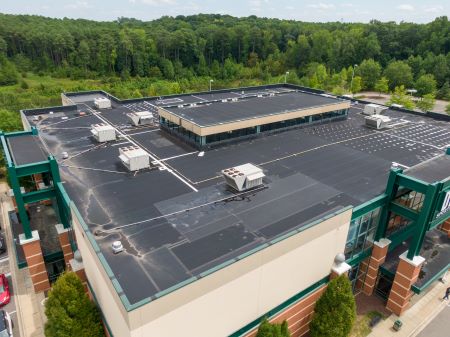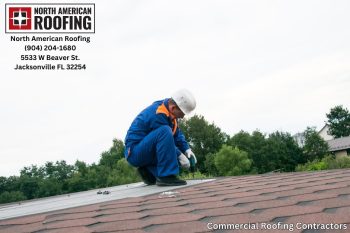The integrity and lifespan of a commercial roof are crucial to safeguarding the assets within a building and ensuring uninterrupted operations. Given the significant financial investment a commercial roof represents, it’s only logical for businesses to seek methods to extend its life. Whether you are familiar with commercial roofing or are diving into the realm of roof maintenance for the first time, understanding the intricacies of the types of commercial roofing and the expertise a commercial roofing company can bring is vital. In this comprehensive guide, we will explore strategies to prolong the life of a commercial roof.
1. Regular Inspections and Maintenance:
The foundation of a long-lasting commercial roof is regular inspections and maintenance. By routinely checking the roof for signs of damage or wear and addressing them promptly, minor issues can be resolved before they escalate into major, cost-intensive problems.
Frequency: Ideally, commercial roofs should be inspected at least twice annually – once after winter and once after summer. Additionally, inspections should follow any severe weather event or incident that could potentially damage the roof.
Professional Involvement: Engaging a reputable commercial roofing company for these inspections ensures that potential issues are identified and addressed competently. Such professionals are well-versed in the various types of commercial roofing and can provide tailored maintenance solutions.
2. Address Repairs Promptly:
Delaying repairs can lead to further deterioration. Whether it’s a minor leak, a small tear in the roofing membrane, or a slightly damaged flashing, timely intervention is crucial. What starts as a minor issue can quickly evolve into structural damage, mold growth, or damaged insulation if left unaddressed.
3. Ensure Proper Drainage:
One of the primary enemies of any roof, especially flat commercial roofs, is stagnant water. Pooled water can lead to leaks, structural degradation, and a host of other problems.
Regular Cleaning: Ensure that drains, gutters, and downspouts are cleared of debris regularly. This facilitates smooth water runoff, preventing pooling.
Inspection of Drains: Apart from cleaning, inspect drains for structural damage or issues that might impede water flow.
4. Protect the Roof from Foot Traffic:
Some commercial roofs need to accommodate regular foot traffic, whether for HVAC maintenance or other reasons. Over time, this traffic can cause wear and tear.
Use Walkway Pads: Installing walkway pads or paths can guide foot traffic along designated routes, ensuring minimal impact on the roofing material.
Limit Unnecessary Traffic: Only allow access to the roof when necessary, and always ensure those accessing the roof are aware of the walkways and any potential hazard areas.
5. Upgrade Insulation:
Good insulation doesn’t just ensure energy efficiency; it also contributes to the longevity of a commercial roof. Proper insulation can prevent thermal shocks and reduce the stress on the roofing material, especially during temperature fluctuations.
6. Implement Reflective Coatings:
Reflective coatings, often used for cool roofing solutions, can extend the life of a roof by reducing the effects of UV radiation and thermal cycling. By reflecting sunlight, these coatings ensure the roof doesn’t absorb excessive heat, thereby reducing expansion and contraction cycles that can strain roofing materials.

7. Be Informed About Your Roofing Type:
Different types of commercial roofing have unique vulnerabilities and maintenance needs. For instance:
Built-Up Roofing (BUR): Requires monitoring for signs of blistering or cracking.
Metal Roofs: Need to be checked for corrosion, especially at seams and fasteners.
Single-Ply Membranes (like EPDM, TPO, or PVC): Should be inspected for punctures, seam separations, or membrane shrinkage.
By understanding the specific needs and vulnerabilities of your roofing type, you can implement a more effective maintenance regimen.
8. Engage a Reputed Commercial Roofing Company for Installations:
The initial installation plays a pivotal role in the longevity of a commercial roof. Faulty installation can lead to recurrent issues and a shortened roof lifespan.
Expertise: Ensure the commercial roofing company you engage has a proven track record with the specific type of commercial roofing you are opting for.
Warranty: A reputable company will offer warranties on their work, adding an extra layer of assurance.
9. Ventilation is Vital:
Proper ventilation ensures a consistent temperature for the roofing system, preventing issues like condensation, mold growth, and ice damming during colder months. Ensure that your roof’s ventilation system is up to par and address any inadequacies promptly.
10. Stay Updated on Roofing Technologies and Trends:
The commercial roofing industry continually evolves, with new materials, technologies, and techniques emerging. By staying informed, you can leverage innovations that could prolong the life of your commercial roof.
Conclusion:
Extending the life of a commercial roof requires a blend of regular maintenance, prompt repairs, and strategic interventions like reflective coatings or upgraded insulation. Given the array of types of commercial roofing, seeking the expertise of a specialized commercial roofing company is invaluable. Such professionals can provide tailored solutions, ensuring that the roof not only lasts longer but also functions optimally, safeguarding the assets within and ensuring peace of mind for the business.
- Commercial Roof Installation Tampa FL
- Flat Roof Repair Tampa FL
- Commercial Roof Maintenance Tampa FL
- Commercial Roofing Contractors Tampa FL
- Commercial Emergency Roof Service Tampa FL
- Commercial Roof Repair Tampa FL
- Roof Coating Company Tampa FL
- Flat Roof Replacement Tampa FL
- Metal Roofing Contractors Tampa FL
- Commercial Roof Replacement Tampa FL
- Flat Roof Installation Tampa FL
- Commercial Roof Installation Asheville NC
- Commercial Roof Installation Orlando FL
- Flat Roof Repair Orlando FL
- Commercial Roof Maintenance Orlando FL
- Commercial Roofing Contractors Orlando FL
- Commercial Emergency Roof Service Orlando FL
- Commercial Roof Repair Orlando FL
- Roof Coating Company Orlando FL
- Flat Roof Replacement Orlando FL
- Metal Roofing Contractors Orlando FL
- Commercial Roof Replacement Orlando FL
- Flat Roof Installation Orlando FL
- Flat Roof Repair Asheville NC
- Commercial Roof Maintenance Asheville NC
- Commercial Roofing Contractors Asheville NC
- Commercial Roof Installation Jacksonville FL
- Commercial Roofing Contractors Jacksonville FL
- Commercial Roofing Contractors Atlanta GA
- Commercial Roofing Contractors Mobile AL
- Commercial Roof Installation Atlanta GA
- Commercial Roof Installation Mobile AL
- Flat Roof Repair Jacksonville FL
- Flat Roof Repair Atlanta GA
- Flat Roof Repair Mobile AL
- Commercial Roof Maintenance Jacksonville FL
- Commercial Roof Maintenance Atlanta GA
- Commercial Roof Maintenance Mobile AL
- Commercial Emergency Roof Service Asheville NC
- Commercial Emergency Roof Service Jacksonville FL
- Commercial Emergency Roof Service Atlanta GA
- Commercial Emergency Roof Service Mobile AL
- Commercial Roof Repair Asheville NC
- Commercial Roof Repair Jacksonville FL
- Commercial Roof Repair Atlanta GA
- Commercial Roof Repair Mobile AL
- Roof Coating Company Asheville NC
- Roof Coating Company Jacksonville FL
- Roof Coating Company Atlanta GA
- Roof Coating Company Mobile AL
- Flat Roof Replacement Asheville NC
- Flat Roof Replacement Jacksonville FL
- Flat Roof Replacement Atlanta GA
- Flat Roof Replacement Mobile AL
- Metal Roofing Contractors Asheville NC
- Metal Roofing Contractors Jacksonville FL
- Metal Roofing Contractors Atlanta GA
- Metal Roofing Contractors Mobile AL
- Commercial Roof Replacement Asheville NC
- Commercial Roof Replacement Jacksonville FL
- Commercial Roof Replacement Atlanta GA
- Commercial Roof Replacement Mobile AL
- Flat Roof Installation Asheville NC
- Flat Roof Installation Jacksonville FL
- Flat Roof Installation Atlanta GA
- Flat Roof Installation Mobile AL
source https://naroofing.com/blog/how-can-i-extend-the-life-of-my-commercial-roof/

No comments:
Post a Comment